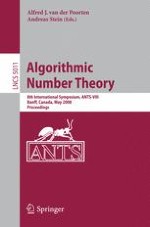This book constitutes the refereed proceedings of the 8th International Algorithmic Number Theory Symposium, ANTS 2008, held in Banff, Canada, in May 2008. The 28 revised full papers presented together with 2 invited papers were carefully reviewed and selected for inclusion in the book. The papers are organized in topical sections on elliptic curves cryptology and generalizations, arithmetic of elliptic curves, integer factorization, K3 surfaces, number fields, point counting, arithmetic of function fields, modular forms, cryptography, and number theory.

























